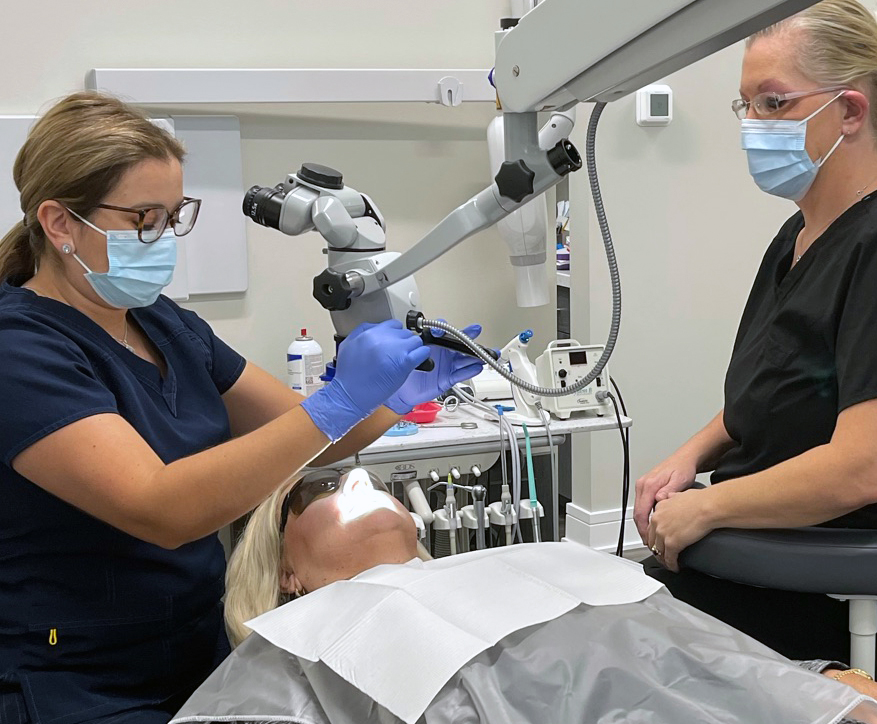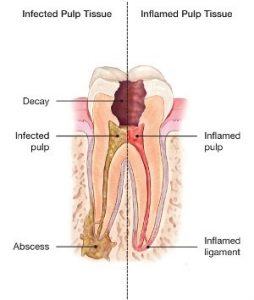We want to ensure that the tooth in question is a good candidate for endodontic therapy. We do this by performing a comprehensive examination to diagnose oral pain and pulpal injury. Treatment options depend on your individual case, and we recommend booking a consultation as soon as possible to prevent further damage. We are experts in the following treatments and can help you preserve your natural tooth.
Treatments & Technology
At our practice, we utilize the most advanced equipment in every operatory room to ensure accurate treatment plans in the most comfortable setting possible. Continue reading below on how we use advanced technology for your care.


We want to ensure that the tooth in question is a good candidate for endodontic therapy. We do this by performing a comprehensive examination to diagnose oral pain and pulpal injury. Treatment options depend on your individual case, and we recommend booking a consultation as soon as possible to prevent further damage. We are experts in the following treatments and can help you preserve your natural tooth.
At our practice, we utilize the most advanced equipment in every operatory room to ensure accurate treatment plans in the most comfortable setting possible. Click here to read more about how we use technology for your care.
Root Canal
We specialize in alleviating tooth pain by treating diseases of the dental pulp while preserving your natural teeth and smile. A root canal treatment is a procedure in which the injured or injected pulp tissue inside a tooth is replaced with a filling material and potentially a crown for protection and will continue the tooth to function as any other tooth would. This endodontic procedure can help not only relieve pain and sensitivity, but also save your natural teeth and prevent the need for dental implants or bridges.
After treatment, numbness could take a few hours to wear off. To avoid biting your lip, tongue or cheek, liquids and soft foods are recommended after numbness subsides. Most patients return to their normal routine the next day. When your root canal therapy has been completed, a record of your treatment will be sent to your referring dentist. You should contact your primary dental office for a follow-up restoration within a few weeks of your treatment.
Success rates for endodontic treatment are generally high. About 90 – 95% of patients who undergo root canal treatment can expect a functional tooth after the treatment. The treated tooth should last a long time, provided good oral hygiene is maintained such as daily brushing and flossing, regular dental checkups and cleanings, and following a healthy diet.

What can I expect during a root canal?
After the endodontist numbs your tooth, a rubber dam that fits over the tooth is used to keep the tooth area dry and free of saliva. The endodontist will then prepare the tooth by drilling an opening. After the decay and bacteria are removed, root canal files will be used to clean out the canals (roots) of the tooth. At the final stage of treatment, the endodontist will fill the canals with a rubber filling material called gutta percha. After the canals are filled, a regular filling will be placed in the tooth. A crown is typically recommended to restore the tooth properly and minimize the potential for cracks.
SYMPTOMS OF DAMAGED OR DISEASED PULP MAY INCLUDE:
-
-
- Sensitivity to hot or cold drinks and foods
- Pain when biting or chewing
- Loosening of the tooth
- Swelling of the gum near the affected tooth
- Oozing surrounding the affected tooth
- Facial swelling
-
POSSIBLE COMPLICATIONS IF TOOTH IS LEFT UNTREATED:
-
- Spreading infection
- Localized bone loss
- Loss of tooth
Causes that may lead to disease or damage to the dental pulp include:
-
-
- Deep-seated and untreated dental decay
- Decay beneath a deep filling
- Trauma that damages a tooth
- Habitual tooth grinding (bruxism)
- Advanced gum disease
-
Misconceptions about root canals:
- Myth #1: Root canal treatment is painful.
- Myth #2: Root canal treatment causes illness.
- Myth #3: A good alternative to root canal treatment is extraction.
- Myth #4: Root canals require many visits to the dentist.
- Myth #5: Crowns cause teeth to need root canals.
- Myth #6: Root canals involve removing the roots of the tooth.
- Myth #7: Pregnant women can’t have root canals.
- Myth #8: The tooth will come out eventually even with a root canal.
- Myth #9: If the tooth doesn’t hurt, there is no need for a root canal.
- Myth #10: After having a root canal, my tooth is completely restored.
- Myth #1: Root canal treatment is painful.
- Myth #2: Root canal treatment causes illness.
- Myth #3: A good alternative to root canal treatment is extraction.
- Myth #4: Root canals require many visits to the dentist.
- Myth #5: Crowns cause teeth to need root canals.
- Myth #6: Root canals involve removing the roots of the tooth.
- Myth #7: Pregnant women can’t have root canals.
- Myth #8: The tooth will come out eventually even with a root canal.
- Myth #9: If the tooth doesn’t hurt, there is no need for a root canal.
- Myth #10: After having a root canal, my tooth is completely restored.
Endodontic Retreatment
If a root canal fails due to improper treatment or failure by a patient to care for the tooth, endodontic retreatment can be used to remove the source of infection, and attempt to save the tooth.
Why does my tooth need retreatment?
Retreatment may be necessary in cases where complete healing did not occur as new problems may appear months or even years after the initial treatment. Possible causes are as follows:
- Curved or narrow canals were not treated during the initial treatment
- Complicated canals were not detected during the initial treatment
- Crown or restoration was not placed within the appropriate amount of time
- Crown or restoration did not prevent saliva from contaminating the inside of the tooth
- New decay can expose a root canal filling material causing infection
- A cracked or loose filling/crown can expose the tooth to new infection
Who performs endodontic retreatment?
The retreatment process is typically more challenging than the initial treatment. This is the reason most dentists refer their patients in need of endodontic retreatment near Chicago to an endodontic specialist. Experts in their field, endodontists receive several additional years of advanced education, which includes the area of retreatment.
What happens during endodontic retreatment?
Once retreatment has been selected, your endodontist will reopen your tooth to gain access to the root canal filling material. This restorative material will be removed to enable access to the root canal. Your endodontist will now clean your canals in order to carefully examine the inside of the tooth. Once cleaned, the canals will be sealed and a temporary filling will be placed in the tooth. Upon completion of this process, please return to your dentist as soon as possible in order to have a new crown or restoration placed on the tooth.
Is retreatment the best option and what is the cost?
The decision to retreat should be made by the patient, dentist, and endodontist. While retreated teeth can last a lifetime, there is no guarantee that treatment will be more successful the second time. The retreatment option should be chosen on a case per case basis. The cost of retreatment varies depending on the complexity of the procedure. It will most likely be more expensive than the initial procedure because your restoration and root filling materials must be removed before the second treatment can begin. Your endodontist may need to spend more time searching for the issues that caused the initial treatment to fail.
Apicoectomy
Generally, conventional root canal treatment is all that is needed to save teeth from extraction. Occasionally, this will not be sufficient to heal the tooth and your endodontist may recommend surgery. Endodontic surgery can also be used to locate fractures or hidden canals that do not appear on x-rays but still manifest pain in the tooth.
An apicoectomy is the most common endodontic surgical procedure. When the roots of a tooth cannot be saved, this procedure replaces them with a filling to provide a stable base for the tooth. This procedure is used to remove infection and/or inflammation from the area around the root tip.
During an apicoectomy, your endodontist will take the following steps:
- First, an incision is made in the gum tissue to expose the bone and surrounding inflamed tissue.
- The damaged tissue is removed, along with the end of the root tip.
- A root-end filling is placed to prevent reinfection of the root and the gum is sutured.
- Bone graft material is placed to aid with the healing of the damaged bone. The bone naturally heals around the root over a period of months, which restores full function.
Pediatric Endodontics
We provide specialty endodontic services to patients of all ages, including children who suffer from a tooth infection or dental trauma. If your child needs treatment due to a traumatic dental injury or damaged tooth, we can treat these issues in a safe and child-friendly environment. We serve patients who need standard root canal treatment, which an adult teen might need, as well as “baby root canals” that are less invasive for younger children.
As a parent, you may wonder why your child needs root canal treatment if primary (“baby”) teeth typically fall out between the ages of six and twelve. There are many good reasons why saving the tooth as long as possible is always the best course of action. For starters, a missing tooth at any age can lead to problems with speech and chewing. Primary teeth also lead the path for the proper placement of permanent teeth, which helps combat crooked or over-crowded placement that can lead to orthodontic treatment over time.

Should my child see an Endodontist or a Dentist?
Endodontists typically have several more years of training in root canals and related procedures compared to general dentists. An endodontist specializes in treating the soft tissue part of the inside of the tooth, with expert knowledge and experience performing root canals and other endodontic treatments. To get your child the proper care he/she needs, we recommend booking a consultation with us as soon as possible.
When does my child need to see an Endodontist?
- Cracked or damaged teeth due to an injury
- Oral injuries as a result of a sports injury, slip or fall are best treated by an endodontist
- Tooth infection caused by painful toothache
- A prolonged toothache may be a signal that the tooth is infected and can be treated with a pulpotomy “baby root canal”
- Tooth sensitivity when consuming certain foods or drinks
- Severe sensitivities to hot or cold could indicate a deep cavity or infected tooth
- Referral from general or pediatric dentist
- Complex root canals and other related treatments are best performed by an endodontist to ensure optimal results
Procedures to help save the injured tooth
An injured immature tooth may need one of the following procedures to improve the chances of saving the tooth:
Apexogenesis
This procedure encourages the root to continue development as the pulp heals. Medication administered by your endodontist helps protect the soft tissue to encourage growth. The tip of the root (apex) will continue to close as the child gets older. In turn, the walls of the root canal will thicken. If the pulp heals, no additional treatment will be necessary. The more mature the root becomes, the better the chance of saving the tooth.
Apexification
In this case, the unhealthy pulp is removed. The Doctors place medication inside the root to encourage a hard tissue to form near the root tip. This hardened tissue provides a barrier for the root canal filling. At this point, the root canal walls will not continue to develop, making the tooth susceptible to fractures. Therefore, it is important to have the tooth properly restored by your dentist.
Traumatic Injuries
Most traumatic dental injuries from an accident, sports injury, or fall that result in loose, cracked, or broken teeth must be properly restored by an endodontist. Injuries to the pulp and nerves of the teeth usually require endodontic surgery. If you should experience a traumatic injury, follow these steps and see your endodontist or dentist as soon as possible:
- Pick up the tooth by the crown (chewing surface), not the root. This should be handled very carefully. Touch only the crown to minimize injury to the root.
- Clean the tooth with water only if dirty. Remember not to handle by the root surface.
- Reposition tooth in socket as soon as possible. The sooner the tooth is replaced, the greater the likelihood it will survive.
- Keep tooth moist at all times. The tooth should not be left out to dry.
- Contact your endodontist immediately. Bring the tooth to a dentist or endodontist as soon as possible, ideally within 30 minutes.
Cracked Teeth
Cracked teeth result in various symptoms such as pain upon chewing, temperature sensitivity, and pain upon release of the biting pressure. The pain can come and go, which makes it difficult to diagnose the cause of discomfort. Chewing may cause movement of the cracked pieces of your tooth, leading to irritation of the pulp. When biting pressure is released, the crack closes quickly resulting in extreme pain. Eventually, this damages the pulp and the tooth will consistently hurt, even when you are not chewing. It is possible that cracks can lead to infection of the pulp tissue, which can spread to the bone and tissue surrounding the tooth. The treatment of cracked teeth may involve a full coverage crown to protect the tooth. If symptoms are severe or infection occurs, tooth extraction may be recommended.

